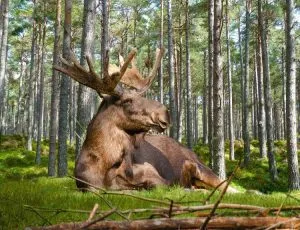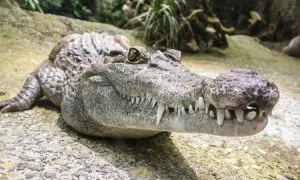These Are the Most Dangerous Animals in the US

Undoubtedly, traveling to various US states is a common habit. Each state has its own set of tourist attractions. In addition to the vistas, every state in the nation is home to a variety of wild species.
Even though we may admire these wonderful animals as part of the natural landscape, few of us consider the potential harm that they might cause. Despite the rarity of animal-human attacks, reading this list might make you pause before taking pictures of any of the animals listed below or the states where they reside.
Michigan: Wolves

According to the Michigan Department of Natural Resources, there are currently 700 adult wolves living and hunting in the state’s Upper Peninsula.
Although this is good news for outdoor enthusiasts, those of us who enjoy taking hikes and going on camping trips in this stunning area should be aware of the danger that wolves pose.
Minnesota: Timber Rattlesnake

Few people are aware that Minnesota also has a population of poisonous snakes because the state has harsh weather all year long.
The Timber Rattler, which lives in rocky caverns and river bluffs, is found in southern Minnesota. When admiring the grandeur of the great Mississippi, exercise caution.
Mississippi: Copperhead

Given how common copperheads are in Mississippi, it’s very likely that you’ll encounter one while taking a nature walk.
Even though they can grow to lengths of over four feet and are typically calm and solitary, copperheads have been known to attack people when startled or disturbed.
Missouri: Coyotes

Large coyote packs are not unusual in Missouri, and they pose the greatest threat to the populations of small animals they prey on.
While you are out walking, coyotes might not pose a threat to you or your dog, but if you come across a pack of them out hunting, you should immediately take cover.
Montana: Grizzly Bears

In Montana, big animals are more likely to bite or injure humans. The likelihood of danger is increased by large animals like grizzly bears.
Grizzly bears encounter people while moving from campsites in search of food and water. The key to keeping intruders out is to store your sundries properly.
Nebraska: Bulls

Nebraska is now recognized as a cattle-producing and cattle-raising state in the Midwest. Unfortunately, not everyone thinks that this company is safe.
Bulls are beaten until they submit, which can lead to explosive situations when the animals snap and attack, killing hundreds of people every year.
Nevada: Deer Mice

Nevada lacks data on animal/human interactions despite being home to black bears, mountain lions, and rattlesnakes.
The deer mouse does, however, pose a threat to us because it disperses the hazardous hantavirus, a disease with a high mortality rate in humans.
New Hampshire: Moose

Because New Hampshire is home to lush forests and an abundance of vegetation, which moose thrive on, moose once again makes the list.
Close-up photography might seem like a good idea, but moose are surprisingly quick for their size and could easily thwart your plans.
New Jersey: Bobcats

Although bobcats are medium-sized cats that are roughly twice as large as domestic cats, they pose a much greater threat to human safety.
The majority of the time, bobcats are timid and unlikely to harm humans, but they can contract rabies from other animals and can become aggressive even when not provoked.
New Mexico: Apache Spider

A close relative of the apache spider is the brown recluse spider, which has piercing bites that gradually infect the entire body.
Similar to the bite of a brown recluse, an apache spider bite can cause necrosis, or widespread tissue death.
New York: Raccoons

Since raccoons are known for hunting trash, New York is the perfect place for them to establish a home. These crafty coons can slink into almost anything.
Since raccoons are one of the breeds most infamous for carrying the disease, rabies is the main issue we must consider when interacting with them.
North Carolina: Fire Ants

Even though there might be more obvious predators in North Carolina by 2020, contact with fire ants was still a major cause of death there.
In North Carolina, one of the 14 states where fire ant infestations have taken hold, the probability of getting bitten by a fire ant rises from 30 to 60% every year.
North Dakota: Bison

North Dakota is home to one of the largest wild bison herds in the United States, raising the possibility that we will eventually encounter them.
You must maintain a safe distance from these enormous animals, which can run at up to 40 mph and leap six feet in the air.
Ohio: Mosquitos

The bite won’t kill you, like their relatives the kissing bugs, but the diseases that come after do put millions of people in danger every year.
Despite the paucity of data on the mortality caused by mosquito bites, mosquitos are known to transmit deadly diseases like the West Nile and Zika viruses.
Oklahoma: Tigers

It’s well known that Oklahoma struggles to successfully house its exotic cats. Numerous lions and tigers escape from zoos each year, according to statistics.
Over the past few years, there have been a number of reports indicating that tigers and humans have come into contact, including one that resulted in fatal injuries.
Oregon: Bats

Nine species of these fuzzy flying mammals find their habitat in Oregon’s woodlands, which provide a comfortable environment. Sightings during the day are extremely rare absent other dangers.
Bats can transmit the rabies disease to humans, and rabid bats can lash out violently and necessitate immediate medical attention.
Pennsylvania: Pumas

The puma is a large cat that is indigenous to the Americas and has a long tail, a tan to light brown coat, and a slightly rounded face.
Even though they enjoy solitude and solitude, pumas have been known to attack people if hunger or a drought persists or if they feel threatened in any way.
Rhode Island: Black Widow Spider

Although there are not many carnivorous animals in Rhode Island, everyone is aware of the beauty and danger of the black widow spider.
Black widow spiders are feared by many arachnophobes due to their distinctive red markings on their powerful legs and bulbous bodies.
South Carolina: Alligators

This enormous reptile is found in South Carolina, a hot, humid state that also has sizable alligator populations in its local ponds and marshes.
People shouldn’t feed alligators because these massive reptiles can’t distinguish between food and your hand.
South Dakota: Porcupines

The porcupine, though commonly regarded as a cute, waddling creature that dwells in the lowlands and woods of Dakota, can be harmful to both people and pets.
Although not deadly, a porcupine’s quills can injure and infect, which can be fatal if untreated. These quills are the animal’s main line of defense.